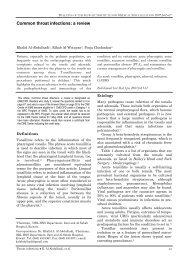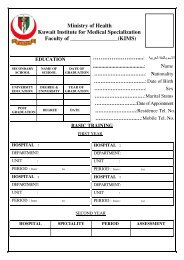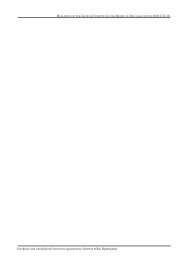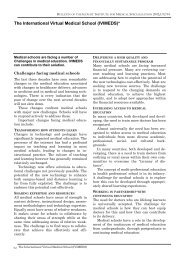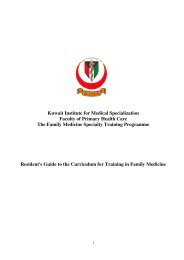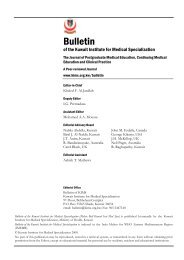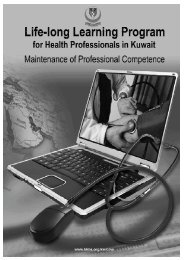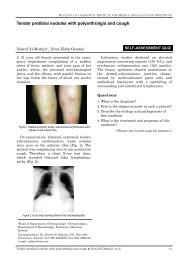Otitis media: a review for the Family physician - Kuwait Institute for ...
Otitis media: a review for the Family physician - Kuwait Institute for ...
Otitis media: a review for the Family physician - Kuwait Institute for ...
Create successful ePaper yourself
Turn your PDF publications into a flip-book with our unique Google optimized e-Paper software.
BULLETIN OF THE KUWAIT INSTITUTE FOR MEDICAL SPECIALIZATION 2003;2:83-89<br />
cause about 20% of <strong>the</strong> AOM episodes. These<br />
organisms include Escherichia coli, Klebsiella,<br />
and Pseudomonas aeruginosa. Even in <strong>the</strong>se<br />
very young infants, however, <strong>the</strong> most common<br />
organisms are still S. pneumoniae and H.<br />
influenzae. 13 Most studies show that 25 to 30%<br />
of middle ear fluid cultures are negative <strong>for</strong><br />
bacteria. Some of <strong>the</strong> cultures are positive <strong>for</strong><br />
viruses, including rhinovirus, adenovirus,<br />
influenza virus, parainfluenza virus, and respiratory<br />
syncytial virus (RSV). Recently viruses<br />
have gained increasing attention as possible<br />
co-pathogenic organisms in both acute and<br />
chronic OME, and may contribute to <strong>the</strong> prolongation<br />
of middle ear effusion. For many<br />
years, <strong>physician</strong>s presumed that viral illness<br />
produced mucosal inflammation and edema<br />
resulting in Eustachian tube dysfunction<br />
characterized by partial or complete obstructtion<br />
of <strong>the</strong> passage and by accumulation of<br />
fluid in some patients. This was recently<br />
confirmed in a study of young adults with<br />
natural rhinovirus infection. 14 Middle ear pressure<br />
changes were measured by a digital tympanometer<br />
at intervals during <strong>the</strong> illness of<br />
<strong>the</strong>se subjects. Abnormal pressure occurred in<br />
74% of patients with rhinovirus illness, and<br />
more than half of <strong>the</strong>se subjects had major<br />
pressure abnormalities. The frequency of subjects<br />
with abnormal middle ear pressures<br />
peaked on days 2 to 5 of illness, a time that<br />
coincides with <strong>the</strong> peak incidence of acute<br />
otitis <strong>media</strong> after onset of respiratory symptoms<br />
in infants and children. Heikkinen et al.<br />
have found that RSV is <strong>the</strong> most commonly<br />
identified virus, being found in 74% of <strong>the</strong><br />
middle ear isolates, followed by parainfluenza<br />
virus and influenza virus. 15<br />
Bacterial Resistance<br />
The most notable trends in <strong>the</strong> bacteriology of<br />
AOM during <strong>the</strong> past decade have been a rise<br />
in <strong>the</strong> proportion of patients infected with<br />
drug-resistant S. pneumoniae and an overall<br />
increase in beta-lactamase-producing H. influenza<br />
and M. catarrhalis. 12 There has been a<br />
profound increase in <strong>the</strong> prevalence of penicillin-resistant<br />
S. pneumoniae in <strong>the</strong> 1990’s,<br />
particularly in <strong>the</strong> pediatric population. The<br />
incidence of penicillin-resistant S. pneumoniae<br />
ranged from 1.8% in 1979 to 8% in 1982, with<br />
an average of 5% from 1979 to 1987. Since<br />
1992, however, <strong>the</strong> incidence of penicillin-resis-<br />
86<br />
tant S. pneumoniae in younger children with<br />
invasive disease has dramatically increased, to<br />
as high as 41% in some studies. 13<br />
Antibiotic resistance occurs most frequently<br />
in patients who had recently been treated <strong>for</strong><br />
acute otitis <strong>media</strong>. A 46% rate of penicillinresistant<br />
S. pneumonia was found in patients<br />
recently treated <strong>for</strong> acute otitis <strong>media</strong>, with<br />
33% of <strong>the</strong>se strains being highly resistant.<br />
The incidence of resistant pathogens is<br />
higher in children who attend day care facilities<br />
in <strong>the</strong> winter time and in children younger<br />
than two years of age. 12<br />
In <strong>the</strong> past, chronic MEE was thought to be<br />
sterile, but studies have shown a 30 to 50%<br />
incidence of positive middle ear cultures in<br />
children with chronic MEE, and polymerase<br />
chain reaction (PCR) testing has revealed that<br />
over 75% of <strong>the</strong> specimens are PCR positive <strong>for</strong><br />
bacterial DNA. The most likely organisms are<br />
again, S. pneumoniae, H. influenzae, M.<br />
catarrhalis, and Group A streptococci. 1<br />
In chronic suppurative OM, <strong>the</strong> most frequently<br />
isolated bacteria are P. aeruginosa. S.<br />
aureus, Corynebacterium, and Klebsiella are<br />
also commonly isolated. Anaerobes may be<br />
common in patients with cholesteatoma. The<br />
standard acute organisms are still found in <strong>the</strong><br />
early stages of disease and may be <strong>the</strong> predisposing<br />
factor toward chronic infection. 1<br />
Medical Treatment<br />
There are many factors that should be considered<br />
in choosing an appropriate agent <strong>for</strong><br />
treatment of acute otitis <strong>media</strong>. These include<br />
<strong>the</strong> activity of <strong>the</strong> drug against <strong>the</strong> usual otitic<br />
pathogens, safety, tolerance, ease of administration,<br />
<strong>the</strong> <strong>physician</strong>’s experience, and cost.<br />
Most of <strong>the</strong> drugs approved <strong>for</strong> <strong>the</strong>rapy of<br />
acute otitis <strong>media</strong> are effective against <strong>the</strong><br />
common otitic bacterial pathogens, although<br />
variations exist among <strong>the</strong>m. For example,<br />
amoxicillin (Amoxil) is ineffective against betalactamase<br />
producing organisms, trimethoprim<br />
– sulfamethoxazole (bactrim or septra) is not<br />
appropriate <strong>for</strong> Group A beta-hemolytic streptococci,<br />
and cefixime (suprax) and ceftibuten<br />
(Cedax) are less active in vitro against pneumococci<br />
than are <strong>the</strong> o<strong>the</strong>r commercially<br />
available oral cephalosporins. 13<br />
There is no single preferred treatment <strong>for</strong> all<br />
infants and children with acute OM. Amoxicillin<br />
is favored by many <strong>for</strong> initial treatment<br />
<strong>Otitis</strong> <strong>media</strong> ● Rehab Alwotayan et al.






